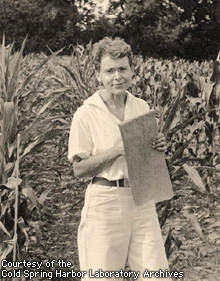|
|
 "Barbara
McClintock taught me a great deal about how to do good research,
how to evaluate evidence, and how not to fall into traps. One lesson
came from a trap she herself almost fell into. Most of her actual
observations were made from colored spots on the corn kernels, which
told her a great deal. And one day she called me and said I should
see what she had. She showed me this ear of corn with these purple
spots and asked me what I saw. And I said, 'Spots, nothing special.'
And she said, 'Don't you see that they're paired?' I looked again,
and suddenly I could see that there were two small ones and two
big ones. And I asked her what that meant, and she said she wasn't
sure, but she thought it was important. She left, and about ten
minutes later she called, and told me to forget it!
"Barbara
McClintock taught me a great deal about how to do good research,
how to evaluate evidence, and how not to fall into traps. One lesson
came from a trap she herself almost fell into. Most of her actual
observations were made from colored spots on the corn kernels, which
told her a great deal. And one day she called me and said I should
see what she had. She showed me this ear of corn with these purple
spots and asked me what I saw. And I said, 'Spots, nothing special.'
And she said, 'Don't you see that they're paired?' I looked again,
and suddenly I could see that there were two small ones and two
big ones. And I asked her what that meant, and she said she wasn't
sure, but she thought it was important. She left, and about ten
minutes later she called, and told me to forget it!
"She tested herself and found that it's very easy to see pairs
in random spots as long as there's no restriction on the distance
between them. So if you have a lot of random spots of different
sizes and you think pairs, you just see them. So she thought she
had seen a specific pattern but immediately realized that it was
a trap.
"McClintock had this amazing mastery of her material. She knew
every little wrinkle of her maize plant, every chromosome, every
gene that she could know at that point. She had an ability to plan
her experiments as if she was almost physically manipulating the
chromosomes. She had that kind of deep knowledge of what was going
on.
"She had an ingenuity in planning that was extraordinary. If
she had something she wanted to know, she found a way to get that
organism to tell her about it. She also had a degree of rigor that
kept her from going beyond what she could really conclude about
her data. It kept her from reaching conclusions until she was absolutely
sure. She didn't publish her major work until years after she had
made her discovery."
more
dispatches »
|
|

 "Barbara
McClintock taught me a great deal about how to do good research,
how to evaluate evidence, and how not to fall into traps. One lesson
came from a trap she herself almost fell into. Most of her actual
observations were made from colored spots on the corn kernels, which
told her a great deal. And one day she called me and said I should
see what she had. She showed me this ear of corn with these purple
spots and asked me what I saw. And I said, 'Spots, nothing special.'
And she said, 'Don't you see that they're paired?' I looked again,
and suddenly I could see that there were two small ones and two
big ones. And I asked her what that meant, and she said she wasn't
sure, but she thought it was important. She left, and about ten
minutes later she called, and told me to forget it!
"Barbara
McClintock taught me a great deal about how to do good research,
how to evaluate evidence, and how not to fall into traps. One lesson
came from a trap she herself almost fell into. Most of her actual
observations were made from colored spots on the corn kernels, which
told her a great deal. And one day she called me and said I should
see what she had. She showed me this ear of corn with these purple
spots and asked me what I saw. And I said, 'Spots, nothing special.'
And she said, 'Don't you see that they're paired?' I looked again,
and suddenly I could see that there were two small ones and two
big ones. And I asked her what that meant, and she said she wasn't
sure, but she thought it was important. She left, and about ten
minutes later she called, and told me to forget it!